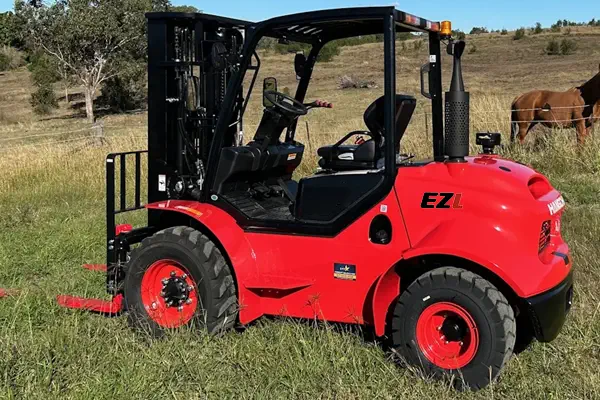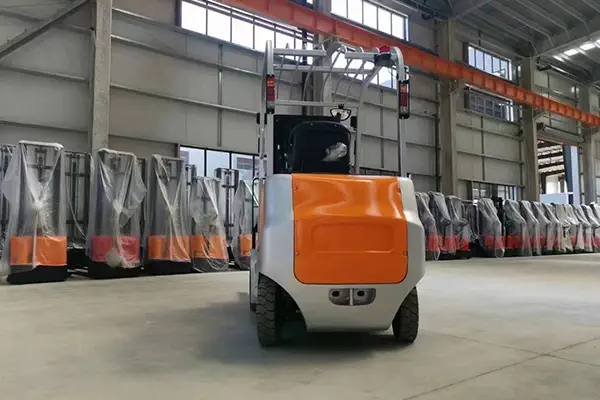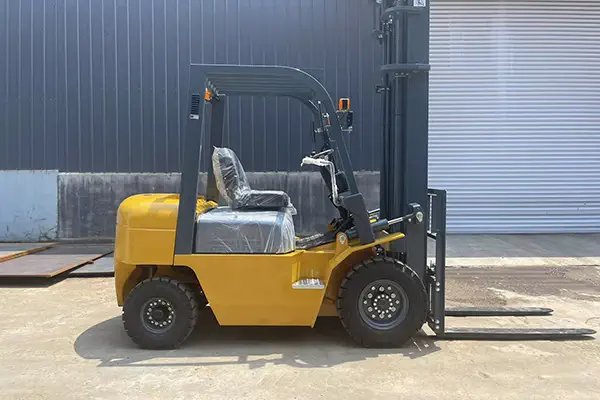
Forklift
We provide various types of Forklifts. If you need customization, please feel free to contact us.
Know More About Forklift
A forklift, also known as a lift truck, fork truck, or forklift truck, is a powered industrial vehicle used to lift and move materials over short distances. Forklifts are essential in various industries, including manufacturing, warehouses, distribution centers, construction, and logistics, as they are designed to efficiently handle heavy loads and transport them with precision. Here are some key details about forklifts:
- Types of Forklifts:: counterbalance forklift, reach forklift, order picker, pallet jack , rough terrain forklift, Telescopic Handler, Electric vs. Internal Combustion Engine (ICE) Forklifts
- Load Capacity: Forklifts are rated for their maximum load capacity, and this capacity can vary significantly depending on the type of forklift and the specific model. It's crucial to ensure that loads do not exceed the forklift's rated capacity to maintain safety.
- Forklift Attachments: Various attachments can be added to forklifts to enhance their versatility. Common attachments include side-shifters, fork positioners, clamp attachments, and rotators, which enable the forklift to handle different types of loads and tasks.
- Safety Features: Forklifts are equipped with safety features, including load backrests, overhead guards, and horns. Additionally, they often have lights and alarms to warn nearby workers of their presence.
- Maintenance: Regular maintenance is crucial to keep forklifts in good working condition. This includes checking the tires, brakes, hydraulics, and all other mechanical and electrical components.
Technical specs comparison of Forklift
| Specification | Unit | LC20 | LC25 | LC30 | LC35 | LC50 | LC70 | LC100 |
| Rated load | ton | 2 | 2.5 | 3 | 3.5 | 5 | 7 | 10 |
| Lifting height | m | 3-8 | 3-8 | 3-8 | 3-8 | 3-5 | 3-5 | 3-5 |
| Machien weight | kg | 3320 | 3680 | 4250 | 4500 | 6700 | 9600 | 12400 |
| Min. turning radius(outside) | mm | 2170 | 2240 | 2400 | 2420 | 2900 | 4180 | 4150 |
| Max. working speed(full-load/no load) | km | 17/19 | 17/19 | 18/19 | 19/19 | 18/19 | 22/29 | 20/26 |
| Engine | / | Xinchai | ||||||
| Engine power | kw | 40 | 40 | 40 | 40 | 60 | 85 | 85 |
Forklift application area

Warehousing and distribution
- Cargo Handling: In warehousing and distribution, forklifts are used to load and unload cargo, especially on pallets. They can quickly and safely unload and load goods from trucks, containers or other transport vehicles, thus speeding up logistics processes. This is a particularly important task since large volumes of goods are often handled in warehousing and distribution.
- Cargo Stacking: Forklifts have the ability to lift forks and stack goods onto high shelves to maximize the use of vertical space. This helps increase warehouse storage capacity and reduce wasted floor space.
- Increased Work Efficiency: Using forklifts reduces manual labor as they are able to handle heavy loads quickly and efficiently. This increases work efficiency and reduces material handling time, thereby lowering labor costs.
Manufacturing field
- Material Handling: Manufacturing requires large quantities of raw materials, components, and semi-finished products, and forklifts are used to move these materials from one area of a warehouse, supplier, or production line to another. This efficient material handling helps ensure that production lines can continue to operate.
- Parts Supply: On assembly lines, forklifts are often used to supply parts and components. Workers can use forklifts to deliver these parts to assembly sites, ensuring an efficient and smooth assembly process.
- Transportation of semi-finished and finished products: Forklifts are used to transport semi-finished and finished products from one production link to the next. This includes transporting finished products from the assembly line to inspection stations, packaging areas or warehouses.


Waste disposal
- Collect and transport waste materials: Waste materials from manufacturing production often need to be promptly cleaned and transported to designated waste disposal areas. Forklifts are used to collect scrap materials from production areas, assembly lines or machines and transport them safely to waste disposal sites or dumpsters.
- Hazardous Waste Disposal: Some waste materials generated during manufacturing processes may fall into the hazardous waste category and require special handling. Forklifts are used to safely collect, transport and store hazardous waste and ensure its disposal in accordance with relevant laws and regulations.
- Maintain cleanliness and safety: Effective waste disposal helps keep the manufacturing environment clean and safe. Forklifts are used to clean up waste materials, prevent accumulation and chaos, and reduce the risk of worker injury and pollution of the production environment.
Ports and shipping
- Cargo handling: Forklifts in ports and shipping are mainly used for loading and unloading cargo. This includes unloading containers from ships and loading them onto trucks or vans, as well as loading and unloading cargo from transport vehicles. Forklifts play a vital role in moving goods quickly and efficiently.
- Cargo Stacking: Forklifts are used to stack cargo into storage areas or container stacking areas. They enable efficient stacking of large goods, making full use of warehouse space.
- Container management: Ports are usually important distribution centers for containers. Forklifts are used to manage containers, including moving containers from stacking areas to unloading stations, loading stations or storage areas, as well as stacking and layering management in stacking areas.


Agriculture field
- Feed and feed storage: Forklifts are commonly used to move and store large quantities of feed and feed raw materials, including hay, feed bags, corn, soybeans and other feed ingredients. This helps ensure dietary supplies for livestock and poultry.
- High-altitude stacking: Some farms use telescopic forklifts to stack feed and feed to store more materials in limited floor space. This is great for making the most of vertical space in a warehouse or storage facility.
- Liquid Fertilizer: Forklifts can also be used to handle large liquid fertilizer tanks and containers for spreading fertilizer on farm fields. This helps improve the fertility of farmland and promotes crop growth.
Forklift Purchase Guide
When purchasing a Forklift, there are several important factors to consider to ensure you get the right machine for your specific needs. Here’s a purchase guide to help you make an informed decision:
- Identify Your Needs: Determine the specific tasks and requirements your forklift will fulfill. Consider factors like the type and weight of the loads you'll handle, the height you need to lift, and the working environment (indoor, outdoor, rough terrain).
- Forklift Types: Understand the different types of forklifts available, such as counterbalance, reach, pallet jack, rough terrain, and order picker. Choose the type that best suits your application.
- Capacity: Determine the maximum load weight the forklift needs to handle. Ensure the forklift's lifting capacity matches your requirements.
- Lift Height: Consider the maximum lift height you need. Forklifts come in various mast configurations, including triple-stage and quad-stage masts, which affect the lift height.
- Fuel Type: Decide on the fuel type, such as electric, LPG, diesel, or gasoline. The choice of fuel depends on your working environment and usage patterns.
- Tire Type: Choose between cushion or pneumatic tires. Cushion tires are suitable for indoor use on smooth surfaces, while pneumatic tires are ideal for outdoor and rough terrain applications.
- New or Used: Decide whether to buy a new or used forklift. New forklifts come with warranties and the latest technology, while used forklifts are more budget-friendly.
- Dealer Reputation: Research and choose a reputable forklift dealer with a history of providing quality equipment and good customer service.
- Maintenance and Parts Availability: Check the availability of maintenance services and spare parts for the forklift model you choose. It's crucial to ensure easy access to maintenance and repairs.
- Operator Training: Ensure that your operators are trained and certified to operate the forklift safely and efficiently.
- Safety Features: Look for forklifts equipped with safety features such as stability controls, seatbelts, lights, and alarms.
- Total Cost of Ownership: Consider not only the upfront cost but also the long-term expenses, including maintenance, fuel, and potential downtime.
- Resale Value: If you plan to upgrade or replace the forklift in the future, consider the resale value of the model you choose.
- Spare Parts Compatibility: Consider whether the chosen forklift model uses widely available spare parts, which can affect maintenance costs and downtime.
If you have questions when purchasing a Forklift or would like to learn more about the performance of our Forklift equipment,
please click the button below to contact us.
FAQ About Forklift
A forklift works by using hydraulic systems to raise and lower its forks or attachments. It can lift heavy loads by sliding its forks underneath the load and then lifting it with the hydraulic system.
There are several types of forklifts, including counterbalance forklifts, reach forklifts, pallet jacks, rough terrain forklifts, and order pickers. Each type is designed for specific applications and environments.
The lifting capacity of a forklift varies depending on the model and type. Forklifts can typically lift loads ranging from 3,000 to 36,000 pounds (1,361 to 16,329 kilograms).
Forklift safety precautions include wearing appropriate personal protective equipment, following speed limits, not carrying passengers, ensuring proper load balance, and using safety features like seatbelts and alarms.
Regular forklift maintenance includes checking fluid levels, inspecting tires, brakes, and safety features, and scheduling routine service according to the manufacturer’s recommendations.
The cost of a forklift varies widely based on its type, capacity, brand, and features. New forklifts can range from a few thousand dollars to over $100,000, while used forklifts are more budget-friendly.
Common forklift attachments include fork extensions, sideshifters, rotators, clamps, and jibs. These attachments allow forklifts to handle a wide range of materials and goods.
Have Anything To Ask Us?
Please fill in your email in the form and we’ll get back to assist you soon!
- Will contact you within 1 hour.
- Don't worry, we hate spam too!









